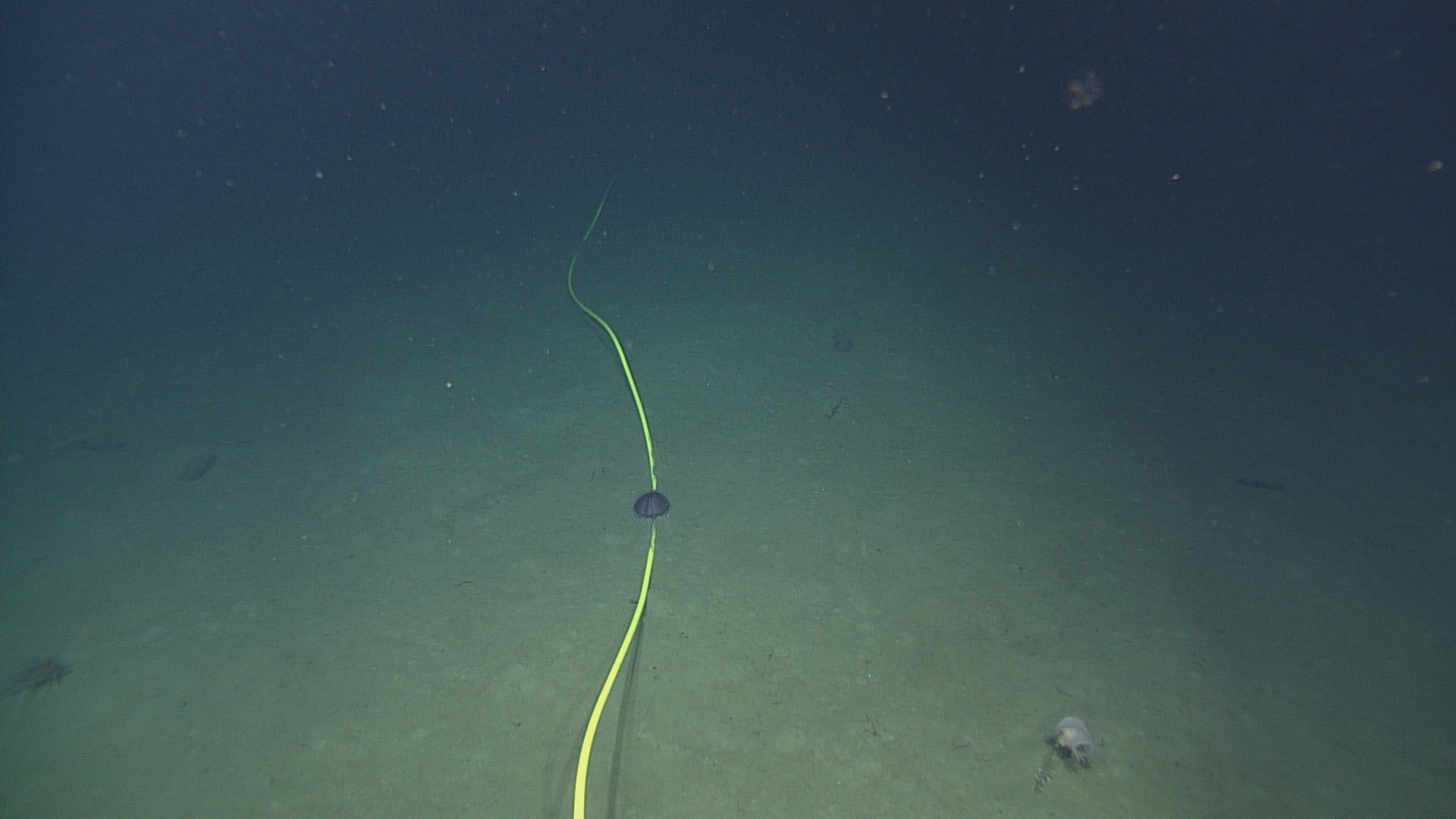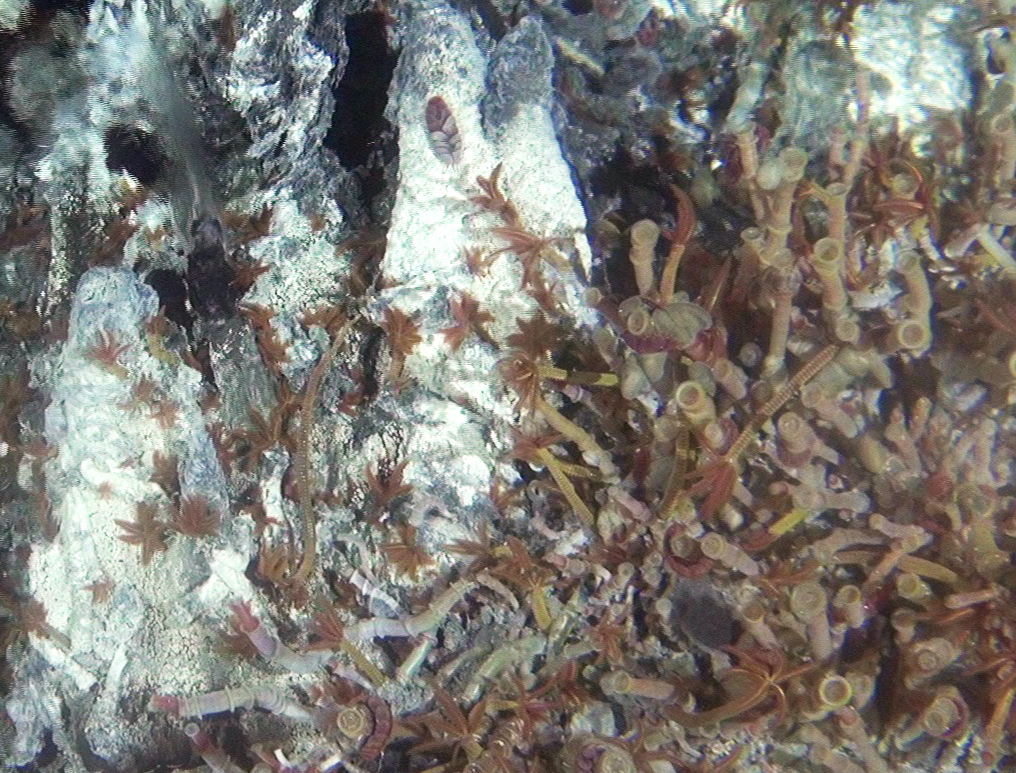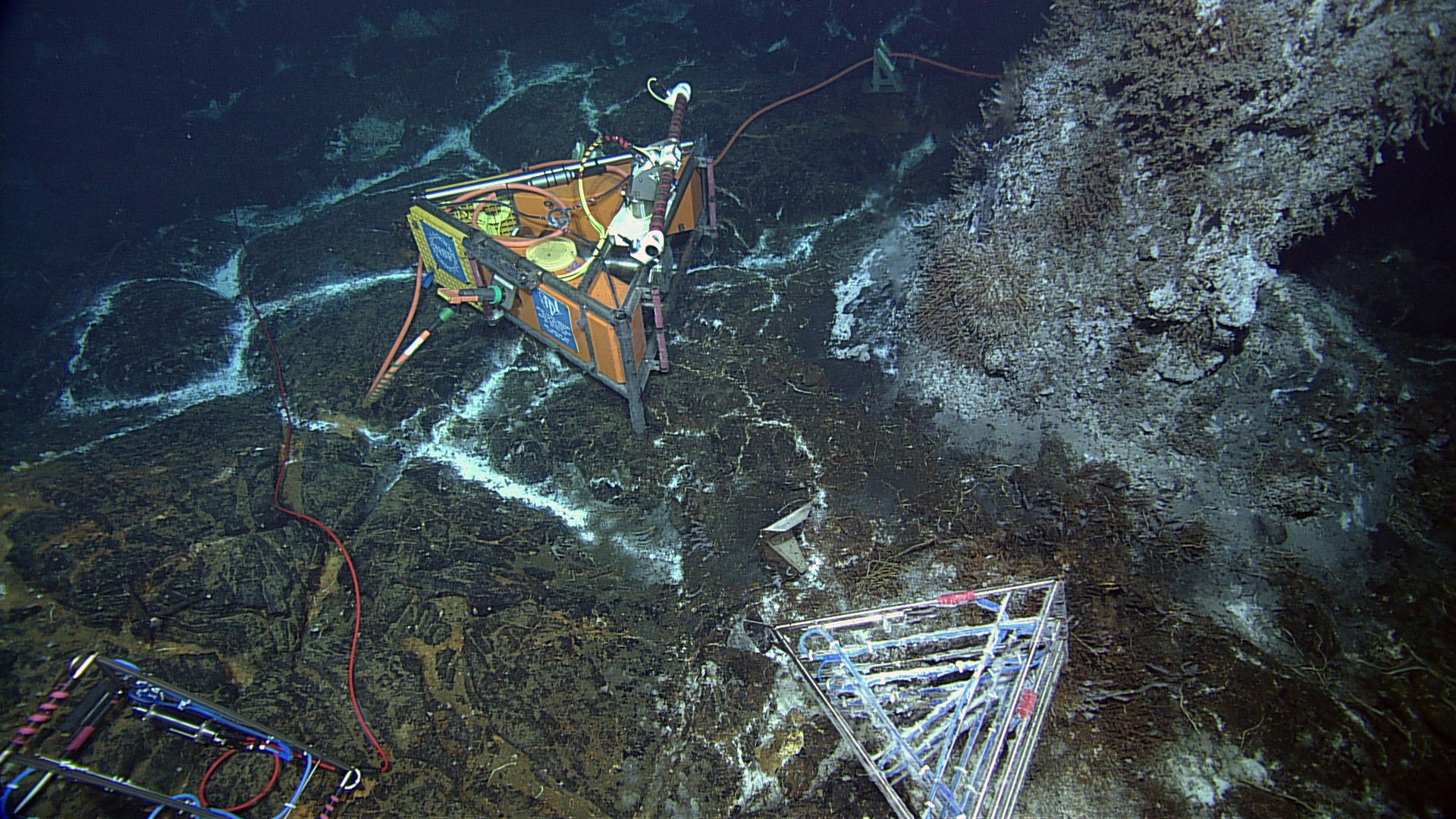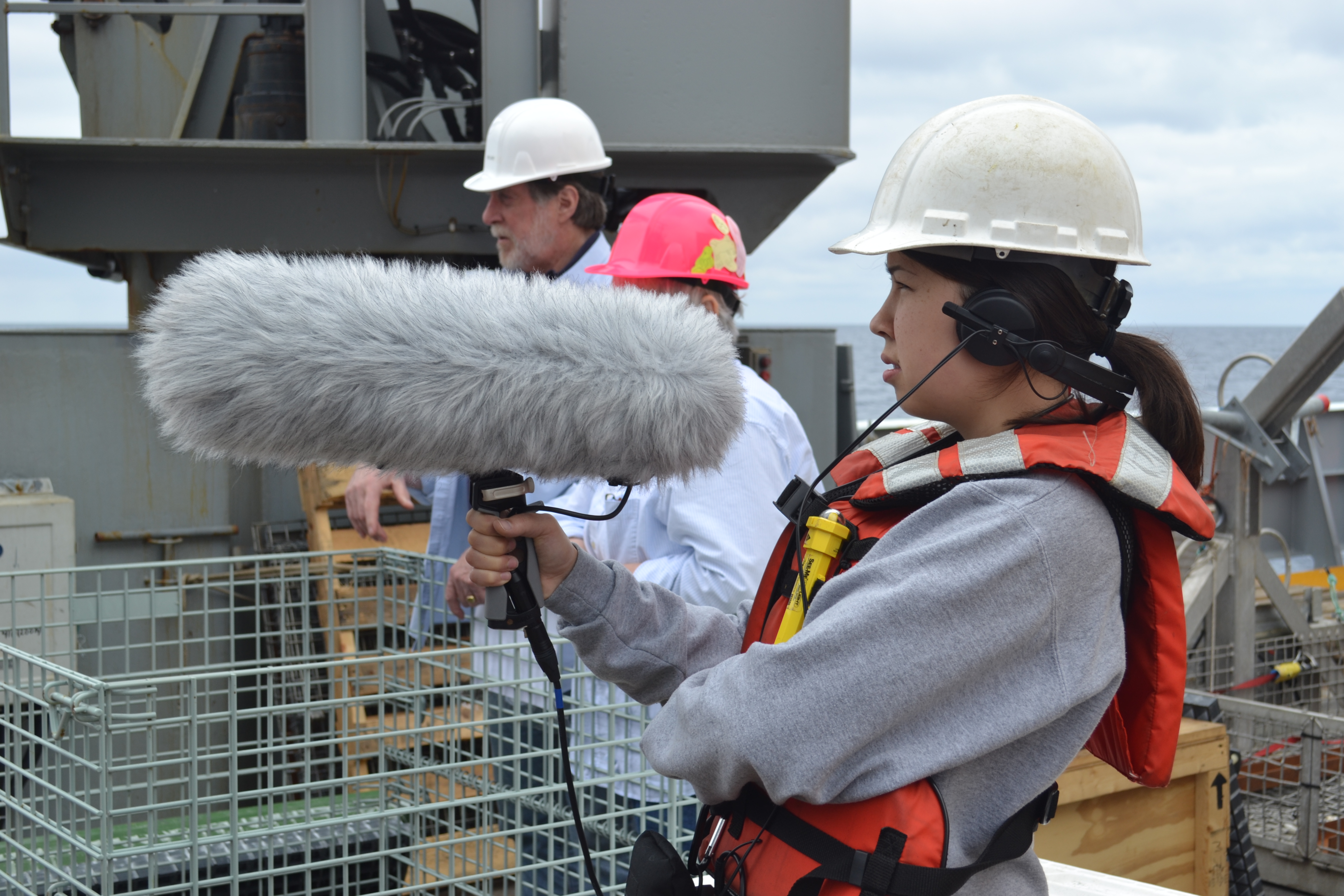Image Archive





























A Venus Flytrap anemone and another deep-sea anemone sharing the same stalk next to wire RS01W6, near the Slope Base site. Photo Credit: NSF-OOI/UW/CSSF; Dive 1734; V14.

A bloom of By-the-Wind Sailors (Velella velella), a type of colonial hydrozoan, seen at the surface at the Slope Base site. Credit: Skip Denny, APL, University of Washington, V'14.

A school of unidentified fish encountered by ROPOS near the surface at the Slope Base site during dive #1734. Photo Credit: NSF-OOI/UW/CSSF; Dive 1734; V14.

An echinothuriid sea urchin encountered following the wire during a survey of the cable lay by ROPOS. A Venus Flytrap Anemone can be seen in the lower right quadrant. Photo Credit: NSF-OOI/UW/CSSF; Dive 1734; V14.

Low Voltage node LV01A on the seafloor at Slope Base, as surveyed by ROPOS. Photo Credit: NSF-OOI/UW/CSSF; Dive 1734; V14.

The port arm of ROPOS reaching for the connector in a flange box on the seafloor at the Slope Base site. Photo Credit: NSF-OOI/UW/CSSF; Dive 1734; V14.

The port arm of ROPOS seating the plug connector of RS01W6 to J1 on Low Voltage node LV01A at the Slope Base site. Photo Credit: NSF-OOI/UW/CSSF; Dive 1734; V14.

An overhead shot from ROPOS hovering above the Slope Base Primary Node, PN1A. Photo Credit: NSF-OOI/UW/CSSF; Dive R1733; V14

A large school of fish near the surface at the Slope Base site. They may be Pacific Sand Lance. Photo Credit: NSF-OOI/UW/CSSF; Dive R1733; V14

A larvacean (the small, white, peanut-shaped object) inside its mucus house, feeding on marine snow at 700m depth at the Slope Base Site. Photo Credit: NSF-OOI/UW/CSSF; Dive R1733; V14

The R/V Thomas G. Thompson steaming into Newport following a successful Leg 1 of the VISIONS '14 cruise. Photo Credit: Kendra Daly, USF

A McLane wire-following profiler, modified to add inductive charging and communications, and holding a CTD, dissolved oxygen, fluorometer and 3D single point velocity sensors. Photo Credit: Kendra Daly, USF

The R/V Thomas G. Thompson docked in Newport between Legs 1 and 2 of the VISIONS '14 cruise. Photo credit: Michael Vardaro, Oregon State University

R/V Thompson docked in Newport between Legs 1 and 2 of the VISIONS14 cruise. Photo credit: Michael Vardaro, Oregon State University

During the evening of July 28th, the Main Lab of the R/V Thompson was filled with the Science and ROV Teams watching the live test of the HD video camera at the ASHES vent on Axial Seamount. The camera had not been turned on for 1 year. The test was a resounding success. Photo Credit: Mitch Elend, University of Washington; V14.

A close up of animals, including palm worms and tubeworms, on the hydrothermal chimney called Mushroom in the ASHES hydrothermal field. The image is a frame grab from video streamed during testing of the OOI-RCA high-definition video camera built by the Applied Physics Lab at the University of Washington. The camera has been at this site for 1 year. Credit: UW/NSF-OOI/ V14.

During ROPOS Dive R1730, the UW-RCA high-definition video camera was tested successfully. The camera was installed in 2013 and 1-year later it worked extremely well. A test 3-D thermistor array (bottom right) that was installed last year rests on a diffuse flow site, covered in microbial filaments. To the left, a cabled 3-D thermistor array will replace the uncabled system. Credit: UW/NSF-OOI/CSSF; Dive ROPOS R1730; V14.

During ROPOS Dive R1729, a digital-still camera (left), a mass spectrometer (middle) and a fluid- and microbial-DNA sampler (right) were installed in the International District Hydrothermal Field at the vent called El Gordo. A titanium 'hat' rests on top of the structure in a tubeworm and limpet patch. Inside the hat are temperature probes and intake nozzles for the fluid and DNA sampler. Credit: UW/NSF-OOI/CSSF; ROPOS Dive R1729; V14.

A huge rattail fish followed the ROV ROPOS around the International District hydrothermal field for several hours. Near the end of the dive it investigated the tool basket, with thoughts that it might get in. Photo credit: UW/NSF-OOI/CSSF; ROPOS Dive 1729; V14.

UW bioengineering student Gina Hansen records audio for one of her video projects. Photo Credit: Mitch Elend, University of Washington, V14

A fiber optic cable has been cut and splayed out so that all of its separate parts can be seen. The tiny little clear wire on the upper right is one of the actual optical fibers, of which there are six within the cable. Photo credit: Jesse Turner, University of Washington, V14.

Friedrich Knuth and Jet Leo take a selfy on the bow, where they conduct their evening workout. Photo credit: Friedrich Knuth, College of Charleston, V14.

The spider crab Macroregonic macrochira is very common at Axial Seamount. Credit:UW/NSF-OOI/CSSF; ROPOS Dive R1727; V14.

The integrated team of UW School of Oceanography Science (Giora Proskurowski), APL- Engineering (Dana Manalang and Trina Litchendorf), and undergraduate student (Christina Ramirez) help ready the digital-still camera for installation in the International District Hydrothermal Field. Photo Credit, Mitch Elend, University of Washington; V14.

The ROCLS cable drum a few meters above the seafloor as it is being lowered by the R/V Thompson's trawl wire. The drum contains >15,000 feet of extension cable. Photo credit: NSF-OOI/UW/CSSF; Dive 1727; V14.

The ROCLS cable drum with >8000 ft of electro-optical cable is lowered on the R/V Thompsons trawl wire for deployment near PN3B. ROPOS will launch shortly, and acquire the drum with a sonar at ~ 600 ft beneath the surface. Near bottom, an acoustic release will free the drum to rest gently on the seafloor so that ROPOS can latch into it and begin the cable installation at Axial Summit. Photo credit: Mitch Elend, University of Washington, V14.

Giora Proskurowski, a Project Scientist with the UW RSN Team, prepares a Remote Access Fluid Sampler (front) and microbial DNA sampler for installation in a diffuse flow site at the vent called 'El Gordo' in the International District hydrothermal field. The instrument is designed by Dr. David Butterfiled and NOAA-PMEL and the UW. Image Credit: Mitch Elend, University of Washington; V14.

Keith Shepherd, ROPOS Operations Manager, and ROPOS Pilot Kim Wallace, guide the R/V Thompson into position to deploy the ROCLS drum onto the seafloor at 5000 ft water depth to begin installation of the 4.6 km extension cable. ROPOS later will latch into the ROCLS drum and begin the cable lay. Photo credit: Mitch Elend, University of Washington, V14.
- Anemone
- Animal
- Arthropod
- ASHES
- Axial
- Axial Base
- Axial Biology
- Axial Caldera
- Bacteria
- Basalt Lava
- BEP
- Biofouling
- biolgoy
- Biology
- Camds
- Camera
- Camhd
- Central Caldera
- Ciliates
- Cnidaria
- Coastal Biology
- Crab
- Deep Profiler Mooring
- Dive Highlights
- Eastern Caldera
- Echinoderms
- Endurance Array
- Engineering Team
- ENLIGHTEN 10
- Exploratorium
- Fish
- Geology
- HD Camera
- HPIES
- Hydrate Ridge
- Hydrates
- Hydrophone
- Hydrothermal Vents
- Illustration
- Inshore 80 Meters
- Instrument
- International District
- J-BOX
- Jason
- Jellyfish
- Junction Box
- K12
- Lava
- Mollusk
- Moorings
- Nodes
- Nudibranch
- Octopus
- OOI
- Oregon Offshore
- Oregon Offshore 600 m
- Oregon Shelf
- Oregon Slope Base
- People
- PN1B
- PN1D
- Polychaetes
- PPSDN
- Primary Node
- RASFL
- ROCLS
- ROPOS
- ROPOS Dives
- ROV Team
- RV Revelle
- RV Sikuliaq
- RV Thompson
- Salp
- Sample
- SC13
- Science Team
- Sea Cucumber
- Sea Star
- Sea Urchin
- Seafloor
- Seismometer
- Sensors
- Shallow Profiler Mooring
- Shark
- Shipboard
- Shore Station
- Slope Base
- Smoker
- Soft Coral
- Southern Hydrate Ridge
- Sponge
- Squid
- Students
- Students & Guest Participants
- Tmpsf
- Tubeworms
- VISIONS 11 Leg 1
- VISIONS 11 Leg 2
- VISIONS 11 Viewers
- VISIONS 13
- VISIONS 14
- VISIONS 15
- VISIONS 16
- VISIONS 17
- VISIONS 18
- VISIONS 20
- VISIONS 22
- VISIONS 23
- Visualization
